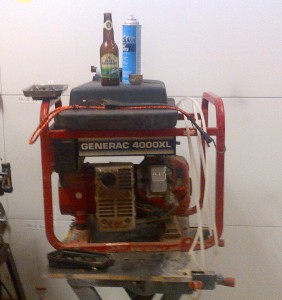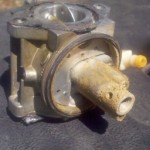Your generator won’t start. Now what?
 By Mike Allen, The Saturday Mechanic
By Mike Allen, The Saturday Mechanic
You put your generator away after Irene, carefully stored in your shed under a tarp, in fact. With the emergency, it’s time to haul it out and keep the lights on. Cool, still more than half a tank full. Fuel tap on, choke on, switch on. And yank.
And yank. Yank until you’re blue in the face. No go. Okay, how about a little ether sprayed into the intake? That makes it cough and run for a few seconds, but never longer. You’re too tired to pull the rope anymore, it’s getting dark, the news is saying that the power is going off pretty much at random. And it’s raining harder every minute. You’re screwed. And in the dark until further notice.
What’s wrong? More importantly, what can you do now, instead of hauling the thing off for repair next week after the emergency is over?
There are two major issues that might keep your generator from starting after a period of storage. If you didn’t drain the fuel, you might have phase separation:(http://saturdaymechanic.com/ethanol-issuesphase-separation-in-gasoline-containing-ethanol/). Water has worked its way into your tank during storage, has made the 10% ethanol that the EPA requires be added to gasoline waterlogged, and that alcohol/water mixture has dropped out into the bottom of the tank. This mix won’t burn, period. Open up the gas tank and look. Phase-separated gasoline looks more like lemonade, cloudy and yellow. The only cure is to completely drain the tank and the float bowl of the contaminated gasoline and start over with fresh gas. There is no way to make them recombine.
You may be able to access the float bowl of your carburetor without major disassembly, by simply unscrewing a single bolt, probably a 1/2″ or 9/16″ brass nut that holds the float bowl on. Just take off the float bowl, clean it with a rag, and then tickle the plastic float a little to purge the last bad gas out of the line. Put it all together, and your generator should start within a couple of pulls.
If you pull your float bowl and you find this kind of glop (http://saturdaymechanic.com/ethanol-issues-varnish-vs-gum-and-using-the-right-additive/) inside, you’ve got a bigger problem. The ethanol forms a gummy deposit that plugs up the internal passages. The only fix for this is to remove the carb and clean it–which may require a gasket set or a mechanic. If the deposits aren’t too bad, try probing the main jet–which will be dead center in the middle of the car–with a toothpick. If you know what a main jet and a float bowl are, you can probably pull this off. If not, you probably will just screw it up. Secure professional help.
(http://saturdaymechanic.com/ethanol-issues-varnish-vs-gum-and-using-the-right-additive/) inside, you’ve got a bigger problem. The ethanol forms a gummy deposit that plugs up the internal passages. The only fix for this is to remove the carb and clean it–which may require a gasket set or a mechanic. If the deposits aren’t too bad, try probing the main jet–which will be dead center in the middle of the car–with a toothpick. If you know what a main jet and a float bowl are, you can probably pull this off. If not, you probably will just screw it up. Secure professional help.
After the storm, you can do a couple of things to prevent this. Always add fuel treatment to gasoline that will be stored more than a month or so. My personal preference for ethanol-adulterated gasoline is Star-Brite’s StarTron. Follow the directions on the label. Better yet, drain the tank and run the generator until it runs dry. Put any leftover gas in your car, and buy fresh gas for the next hurricane.
Editor’s note: Please be sure to use your generators safely and properly. Governor’s Christie’s office issued a Gerenator Safety Advisory. You can find it here.











Art for President!
Good advice!
It’s also good to pay attention to the oil level and keep an extra container around.
Congratulations, Art. You only took 7 paragraphs in order to tell people that they should consult the owner’s manual that they received when they bought their generator.